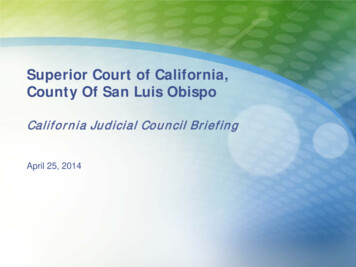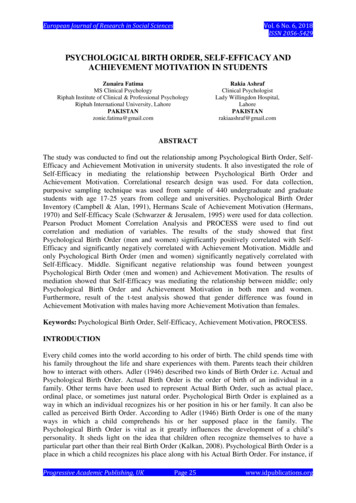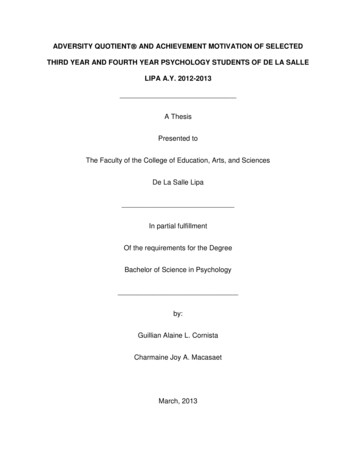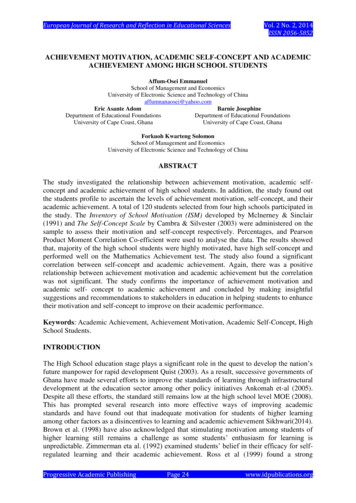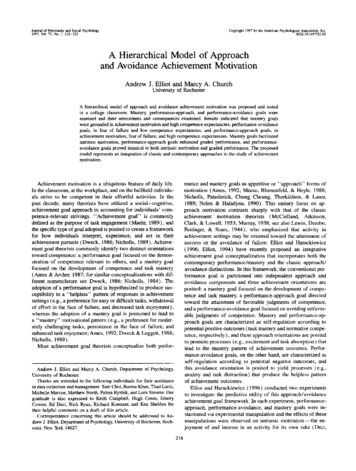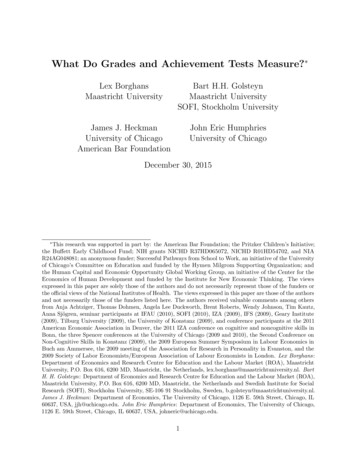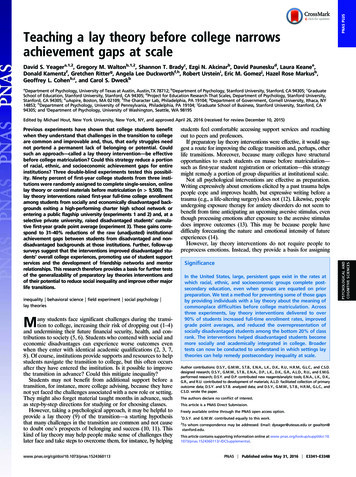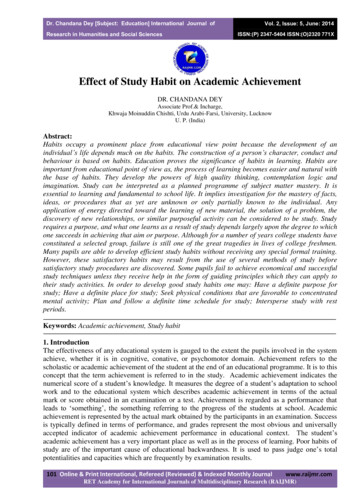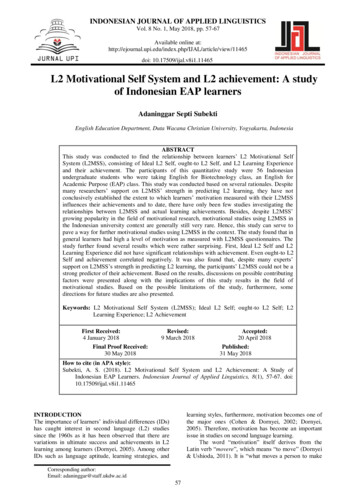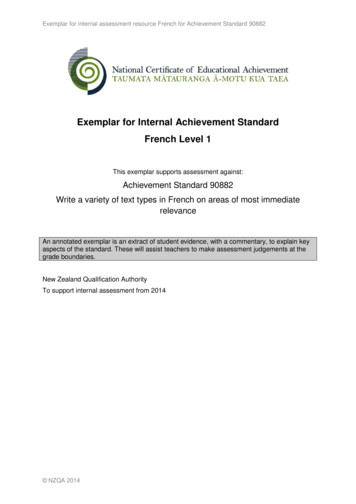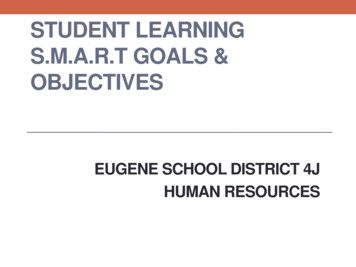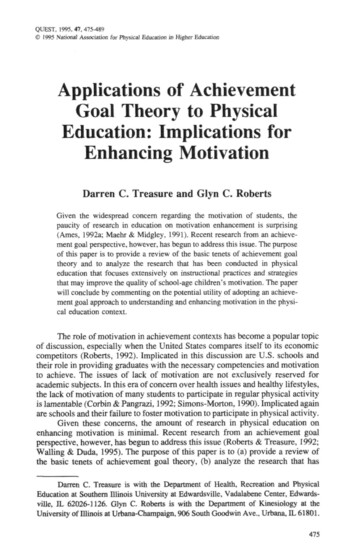
Transcription
QUEST, 1995.47,475-489 1995 National Associalion for Physical Eduction in Higher EducationApplications of AchievementGoal Theory to PhysicalEducation: Implications forEnhancing MotivationDarren C. Treasure and Glyn C. RobertsGiven the widespread concem regarding the motivation of students, thepaucity of research in education on motivation enhancement is surprising(Ames, 1992a; Maehr & Midgley, 1991). Recent research from an achievement goal perspective, however, has begun to address this issue. The purposeof this paper is to provide a review of the basic tenets of achievement goaltheory and to analyze the research that has been conducted in physicaleducation thai focuses extensively on instructionial practices and strategiesthat may improve the quality of school-age children's motivation. The paperwill conclude by commenting on the potential utility of adopting an achievement goal approach to understanding and enhancing motivation in the physical education context.The role of motivation in achievement contexts has become a popular topicof discussion, especially when the United States compares itself to its economiccompetitors (Roberts, 1992). Implicated in this discussion are U.S. schools andtheir role in providing graduates with the necessary competencies and motivationto achieve. The issues of lack of motivation are not exclusively reserved foracademic subjects. In this era of concem over health issues and healthy lifestyles,the lack of motivation of many students to participate in regular physical activityis lamentable (Corbin & Pangrazi, 1992; Simons-Morton, 1990). Implicated againare schools and their failure to foster motivation to participate in physical activity.Given these concems, the amount of research in physical education onenhancing motivation is minimal. Recent research from an achievement goalperspective, however, has begun to address this issue (Roberts & Treasure, 1992;Walling & Duda, 1995). The purpose of this paper is to (a) provide a review ofthe basic tenets of achievement goal theory, (b) analyze the research that hasDarren C. Treasure is with the Department of Health, Recreation and PhysicalEducation at Southern Illinois University at Edwardsville, Vadalabene Center, EdwardsvilJe, IL 62026-1126. Glyn C. Roberts is with the Depanment of Kinesiology at theUniversity of Illinois at Urbana-Champaign, 906 South Goodwin Ave., Urbana, IL 61801.475
476TREASURE AND ROBERTSbeen conducted in physical education, and (c) comment on the potential utilityof adopting an achievement goal approach to understanding and enhancing motivation in the physical education context.Achievement Goal TheoryThe construct of perceived ability has been one of the most popular psychological variables attended to by motivational researchers in physical activitycontexts. The predominant focus in this literature has been to ascertain thecognitive, affective, and behavioral antecedents and consequences of varyinglevels of perceived ability (Feltz, 1992; Roberts, 1984; Roberts, Kleiber, & Duda,1981). For the most part, the self-percept of ability has been assumed to referto how much ability an individual has relative to others. Recent research from anachievement goal perspective, however, suggests that more than one conception ofability exists and that an individual's cognitive and affective pattems are determined by the conception of ability adopted.Based on developmental work with children, Nicholls concluded that thedevelopment of the concept of ability is a process of differentiating the conceptsof luck, task difficulty, and effort from ability. Following a series of experiments,Nicholls (1984; Nicholls & Miller, 1984) concluded that young children werenot able to differentiate between the concepts, but that by the age of 12, childrenwere able to differentiate task difficulty, luck, and effort from ability. Two recentstudies have demonstrated that the same developmental process occurs in thephysical activity context (Smith & Whitehead, 1994; Walling, 1994). Nicholls(1980, 1984, 1989) contends, therefore, that two conceptions of ability manifestthemselves in achievement contexts for children ages 12 and older, namely, anundifferentiated conception of ability and a differentiated conception of ability.Reaching this developmental stage, however, does not necessarily dictatethat a differentiated conception of ability will be automatically invoked by individuals over the age of 12. Rather, individuals will approach a task with personalperceptions and beliefs about the particular achievement activity in which theyare engaged (Dennett, 1978; McArthur & Baron, 1983; Nicholls, 1980, 1984,1989). The conceptions of ability they employ, and how they interpret theirperfonnance can be understood in terms of these perceptions and beliefs. In otherwords, these prerceptions and beliefs form a personal theory of achievement atthe activity (Nicholls, 1989). The adopted personal theory of achievement affectsone's beliefs about how to achieve success at the activity. Therefore, people willdiffer as to the conception of ability they use and in how they use it based upontheir personal theory of achievement.Nicholls (1984) contends that the two conceptions of ability representdiffering personal theories of achievement, and are embedded within two orthogonal achievement goal orientations. These two goal orientations are related to theconception of ability adopted by an individual, and they act as goals of action,reflecting the individual's personal theory of achievement within a particularachievement context. In this paper, the terms task and ego wilJ be used to describethe two goal orientations (Nicholls, 1980, 1984, 1989). An individual who is taskoriented utilizes an undifferentiated conception of ability, focusing on developingskills, leaming new skills, and demonstrating mastery at the task. The demonstra-
ACHIEVEMENT GOAL THEORY4T7tion of ability is based on maximum effort and is self-referenced. In contrast, anindividual who is ego oriented utilizes a differentiated conception of ability,focusing on demonstrating ability by being successful with minimum effort andoutperforming others.In addition to reflecting personal criteria for success, individuals' persona!goals are also assumed to be linked to their "woridviews" about the purposesof education in a conceptually coherent fashion (Nicholls, 1989; NichoUs, Chueng,Lauer, & Patashnick, 1989; Nicholls, Patashnick, & Nolen, 1985). A task orientation has been found to be associated with the belief that one should undergoeducation so that one's commitment to society and desire to continue leamingshould be enhanced. In contrast, an ego orientation is associated with the beliefthat education is a means to an end, namely, wealth and enhanced social status.This research has also indicated that the more ego oriented an individual is (i.e.,the more committed she or he is to outperforming her or his peers), the morethe individual sees normative ability and attempts to do better than others ascauses of success. On the other hand, the more task oriented an individual is,the more she or he believes that success depends on effort, interest, and attemptsto leam new skills.Personal Goals and Physical EducationAlthough a considerable amount of research has focused on the relationshipbetween personal goals and sport involvement (Duda, 1989; Duda, Fox, Biddle, &Armstrong, 1992; Duda & Nicholls, 1992; Lochbaum & Roberts, 1993; Roberts,1984; Treasure, & Roberts, 1994), only a few studies have applied and tested theconceptual relevance of achievement goal theory to physical education. Congmentwith the classroom and sport domains, what research that has been conductedhas consistently shown that achievement goal orientations are pertinent to thephysical education experience. Walling and Duda (1995) found that studentshigh in ego orientation were more likely than iow ego oriented students to expressthe belief that success in physical education is achieved when they possess highability. In addition, high task oriented students were significantly more likely tobelieve that success is achieved through intrinsic interest in the activity, cooperation, and high effort than low task oriented students. Finally, high task/low egostudents were the least likely to believe that success stems from leaming toskillfully deceive the teacher. Congruent with the findings of Walling and Duda(1995), Papaioannou and Duda (1993) have reported a positive relationshipbetween a task orientation and intrinsic motives for panicipation with a sampleof Greek adolescent physical education students.Situational Influences and Achievement GoalsWhile one avenue of research related to achievement goals has demonstratedthat individual differences in dispositional goal orientation are associated withdifferent motivational processes, another avenue of research has focused onsituational influences. This research has examined how the structure of the environment can make it more or less likely that a particular achievement goal willbe adopted. The premise of research from a situational perspective is that thenature of children's experiences and how they interpret these experiences influ-
478TREASURE AND ROBERTSence the degree to which task and ego involvement is perceived as salient withinthe context. This is assumed to affect the achievement behaviors of children sothat they adopt adaptive achievement strategies (namely, to work hard, to seekchallenging tasks, or to persist in the face of difficulty) in task-involving situationsand adopt maiadaptive achievement strategies (namely, to seek easy tasks, toreduce effort, or to give up in the face of difficulty) in ego-involving situations(see Ames, 1992a).In a study with academically advanced high school students, Ames andArcher (1988) reported a strong positive relationship between the perceptionof a task-involving motivational climate and adaptive motivational processes.Specifically, students who perceived their experiences as task involving weremore likely to use effort strategies, preferred challenging tasks, liked the classmore, and believed success and effort covaried. Papaioannou (1995) has reportedsimilar findings in a physical education setting. Papaioannou found that whenthe physical education setting was perceived as high in task involvement andlow in ego involvement, students attributed success to effort and not ability.Additionally, irrespective of level of perceived ability, the perception of hightask involvement was a strong predictor of various indices of motivation inphysical education, such as intrinsic motivation, interest in the lesson, perceivedimportance of the lesson, perceived behavioral control, intentions for high effort,and intentions for participation in all physical education classes. In contrast,perceptions of high ego involvement were either negatively related or unrelatedto motivational indices.In summary, recent research has demonstrated that two types of achievementgoals determine the achievement behaviors and strategies of children and adolescents in achievement contexts including physical education. In addition, themotivationa] climate created by teachers also affects students' achievement behaviors and strategies.An Interactionist PerspectiveChildren's cognitive and affective responses in physical education settingsvary as a function of individual differences in goal orientation and as a functionof perceptions of the motivational climate, but these two variables have tendedto be examined separately. It has been suggested, however, that an interactionistapproach that looks to combine both types of variables promises to provide amore complete understanding of children's achievement behaviors and theirperceptions of the physical education experience (Papaioannou, 1995; Roberts &Treasure, 1992).In an interactionist approach that integrates these two variables, dispositional goal orientation may be viewed as an individual difference variable that* 'determinels] the a priori probability of adopting a particular goal and displayinga particular behavior pattern, and situational factors are seen as potentially alteringthese probabilities" (Dweck & Leggett, 1988, p. 269). For example, in a physicaleducation class affording a choice between an ego goal and a task goal, anindividual's predisposition toward one of these goals should hold sway if thecues from the situation are not too powerful. If, on the other hand, the situationalcues are powerful in favor of either goal, predispositions may be overridden, andgreater homogeneity among individuals may result. The stronger the predisposi-
ACHIEVEMENT GOAL THEORY479tion, either the less likely it is to be overridden by situational cues or the strongerthe situational cues need to be to override it. Altematively, the weaker thepredisposition, the more easily it can be altered by situational cues. This viewof how dispositional variables and situational cues combine would lead one toexpect students to behave inconsistently across situations when the strength ofthe situational cues varies across these situations. It is also expected that childrenand young adolescents, who have yet to firm up their personal theories of achievement, may be more susceptible to the structure of the motivational climate thanolder adolescents and adults.In a follow-up study to their 1988 study, Ames and Archer (1990) examinedchanges in students' motivation pattems as the students moved to classes thatwere stronger or weaker in task involvement. Students' use of effective strategies,preference for challenging tasks, a positive attitude toward leaming, and attributions to effort were all found to co-vary with changes in task involvement. Forstudents who perceived an increase in the task-involving nature of the classroomfrom one year to the next, there was a corresponding increase in each of themotivation variables. Ames and Archer also found that both the students' use ofeffective strategies and a positive attitude toward the subject matter were enhancedby the number of years the students had task-involving experiences. Althoughthis study did not assess individual differences in goal orientation, it does suggestthat the longer an individual perceives the motivational climate to be more orless ego or task involving, the more likely the individuals to behave in accordancewith the structure of the situation.In the sport context, Seifrez, Duda, and Chi (1992), in a study focusing onhigh school varsity male basketball players, examined the degree to which intrinsicmotivation and attributional beliefs are a function of perceptions of the motivational climate, dispositional goal orientation, or a combination of both variables.The findings of this study indicated that attributional beliefs were best predictedby an individual's goal orientation. Specifically, a task orientation predicted thebelief that effort causes success, whereas an ego orientation predicted the beliefthat ability causes success. Both perceptions of the motivational climate and goalorientation predicted intrinsic motivation. While perceptions of the motivationalclimate and dispositional goal orientation emerged as predictors of enjoyment,dispositional goal orientation was the predominant predictor of reported effortexerted and perceived competence in basketball, whereas motivational climatesignificantly predicted reported tension in basketball. It appears that how oneviews achievement situations generalizes across situations, but how one experiences these situations may shift according to the motivational climate.Enhancing MotivationThe issue remains, however, of how to enhance the motivation of studentsin physical education. Although individual remediation to enhance the qualityof motivation by affecting change in a child's dispositional goal orientation maybe effective, to concentrate on individual change is not very practical in mosteducational contexts. In addition to being expensive and time consuming, recentresearch suggests that children perceive the meaning and purpose of the achievement context in different ways and that these perceptions influence the goals
480TREASURE AND ROBERTSthat children themselves adopt, thereby influencing the quality of motivation(Ames & Archer, 1988; Maehr & Midgley, 1991). Consequently, although establishing linkages between the achievement contexts, goals, and student motivational outcomes has been important, strategies to determine how physicaleducators may most effectively use this information to enhance motivation andfoster adaptive achievement behaviors need to be developed. To this end, agrowing body of literature exists to suggest that the teacher plays an active rolein the construction of children's perceptions of the motivational climate and,consequently, the quality of children's motivation (see Epstein, 1988, 1989).What most researchers have suggested, therefore, is that time and effort be spentin developing strategies and instructional practices to facilitate the teacher increating a task-involving motivational climate (Ames, 1992a, 1992b; Maehr &Midgiey, 1991; Roberts, 1984; Roberts & Treasure, 1992).Epstein (1988, 1989) has argued that various structural features of theachievement context have been consistently identified as influencing a wide rangeof motivational processes. TTiese structural features are interdependent variablesand, when taken together, define the motivational climate of a context. Epsteincoined the acronym TARGET to represent the task, authority, reward, grouping,evaluation, and timing stmctures of the achievement context, and she contendsthat how the teacher goes about structuring the context determines, to a greatextent, whether a child will perceive the context as task or ego involving. AdoptingEpstein's (1989) approach, Ames and Maehr (1989) have recently developed aclassroom-based intervention that has successfully facilitated a task-involvingmotivational climate. When compared to similar students in a control group,students who had been defined as being at risk educationally and who had beentaught by teachers trained to create a task-involving climate, reported significantlyhigher levels of perceived ability, effective leaming strategies, intrinsic motivation, and favorable attitude toward the activity. TTie findings suggest that themotivational climate created in the intervention classrooms enhanced adaptiveachievement strategies. Thus, training teachers to structure the leaming environment toward task involvement significantly affected the students' achievementbehavior.To date, only one study has been conducted in a physical education contextthat has attempted to manipulate the motivational climate. Adopting the interactionist perspective outlined above. Treasure (1993) hypothesized that by manipulating the structure of the physical education context so as to be strongly taskor ego involving, perceptions of the motivational climate would override dispositional goal orientations and be more predictive of children's cognitive and affective responses. The participants for this study were 111 sixth- and seventhgrade children (age M 12.1 years) attending a middle school in the Midwestof the United States. The sample consisted of 58 females and 53 males. Thisstudy focused on the instruction of basic soccer skills adapted from the EnglishFootball Association's Soccer Star scheme (Russell, 1988) and took place during10 successive sessions of the children's daily physical education class. In orderto test the hypothesis of this study, the children were randomly assigned to atask- or ego-involving treatment condition.Adapting the intervention model developed by Ames and Maehr (1989),Treasure's (1993) study initially involved identifying those strategies that areconsistent with promoting either an ego or task achievement goal in a physical
ACHIEVEMENT GOAL THEORY481education setting and organizing these strategies into Epstein's six TARGETareas. Each strategy was then operationalized in temis of a wide range of specificinstructional practices to facilitate the teacher's actual implementation of thestrategies. The intervention model, therefore, afforded the comparison betweenan ego-involving motivational climate that emphasized normative standards ofperformance typically found in physical education settings with a task-involvingmotivational climate that focused on leaming and personal improvement.Although the manipulation of the motivational climate has been successfullyachieved in a classroom setting (Ames & Maehr. 1989), Treasure's (1993) studywas the first to attempt to manipulate the motivational climate of a physicaleducation context. Consistent with research from classroom settings, the resultsof a series of manipulation checks suggest that situational factors and instructionaldemands can influence a child's perception of the physical education experience.Specifically, the findings clearly demonstrated that those children who panicipated in the ego treatment condition perceived the motivational climate to beego involving, and those children who participated in the task condition perceiveda task-involving motivational climate. After the success of the manipulation ofthe motivational climate had been confirmed, the main hypotheses of the studywere addressed.In contrast to the results of Seifrez et al. (1992), who found that, in anaturally occurring sport context, both dispositional goal orientations and perceptions of the motivational climate predicted cognitive and affective responses, theresults from Treasure's (1993) study demonstrated that by manipulating theTARGET structures of the achievement context, a physical education teachercan affect the motivational climate of the achievement context to override thedispositional goal orientations of students. Congruent with the classroom-basedwork of Ames and Maehr (1989), the results of this study also demonstrated theease of inducing an ego or task goal in a physical education setting. This is asignificant finding. By manipulating the TARGET stmctures of the context, itappears that a teacher can foster a particular achievement goal and in so doingplay an active role in constructing a child's physical education experience.Consistent with recent classroom interventions (Ames & Maehr, 1989). theresults of Treasure's (1993) study also demonstrated that students who perceive amotivational climate in which the demonstration of ability is based on personalimprovement and effort manifest a significantly more adaptive pattem of achievement cognitions and affective responses than those who perceive a physicaleducation context in which the demonstration of ability is based on normativeability and outperforming others. Specifically, the children in the task treatmentcondition indicated that they preferred engaging in more challenging tasks, believed success was the result of motivation and effort, and experienced moresatisfaction with the activity than did the children in the ego treatment condition.Children who participated in the ego treatment condition, however, reported thatdeception was a key to success.It has been suggested that fostering task involvement may be a particularchallenge in the context of physical activity because competition is inherent inthe activity (Duda, 1992). The results of this study, however, suggest that in arelatively short period of time, a teacher can structure a physical education contextin such a way as to influence a child's recognition of a task involving motivationalclimate and. in so doing, significantly enhance the child's quality of motivation.
482TREASURE AND ROBERTSFrom a motivational perspective. Treasure's (1993) study clearly shows not onlythat it is possible to create a task-involving climate but also that children thrive insuch a context. Task involvement enhances motivation within physical education.Based on Treasure's (1993) findings, and the fmdings from the academicclasses (Ames, 1992a), we would like to suggest some strategies that a physicaleducator could use to foster task involvement and, in so doing, to enhance thequality of children's motivation in physical education. We shall address each ofEpstein's (1988, 1989) TARGET structures in tum.TaskA central element of any achievement context is the design of tasks andleaming activities. Embedded in tasks is information that children use to makejudgments about their ability, their willingness to apply effort, and feelings ofsatisfaction (Ames, 1992a). Research has demonstrated that tasks involving variety and diversity are more likely to facilitate an interest in leaming and taskinvolvement (Marshall & Weinstein, 1984; Nicholls, 1989; Rosenhoitz & Simpson, 1984). To enhance task involvement, therefore, individuals should engagein different tasks and have different assignments. As Rosenhoitz and Simpson(1984) contend, working on different tasks, or having different assignmentsprovides less opportunity, or need, for students to compare their performance toothers'. Hence students develop a sense of their own ability that is not dependenton social comparison. For example, during a basketball class, students shouldhave a choice of size of ball to use while the teacher sets different tasks for thestudents dependent on their level of development. Another strategy that couldbe utilized to capture student interest and enhance enthusiasm involves gettingthe children to set their own short-term, realistic goals. Through this, studentswill begin to understand the steps to ieaming complex physical tasks and, consequently, will begin to see the task as more manageable, focus on their ownprogress, experience success, and become more confident in their ability.AuthorityThe locus of responsibility in the leaming situation is often defined as thedegree to which teachers involve children in decision making, and is related toadaptive or positive motivation pattems in children (Ames, 1992a). Evidencesuggests that children's feelings of perceived ability tend to be higher in classrooms in which the decision-making process is shared between the teacher andstudent (Grolnick & Ryan, 1987; Ryan, Connell, & Deci, 1985; Ryan & Grolnick,1986). To enhance task involvement, therefore, students should (a) be given theopportunity to participate actively in the leaming process by choosing the tasksthey want to leam, (b) be expected to set up equipment and tests, and (c) monitorand evaluate their own and, when appropriate, their partner's perfonnance duringtesting sessions. For example, during a dribbling soccer skills test, students couldwork together to set up the dribbling course correctly and then monitor theperfonnance of each other by recording times on successive trials measured witha stopwatch.
ACHIEVEMENT GOAL THEORY483RewardsThe use of rewards and incentives is one of the more obvious aspects ofa child's physical education experience. It often seems that rewards and incentivesare more imponant than the actual activity itself. Although given with goodintentions to motivate children, rewards and incentives can have paradoxical anddetrimental effects when they are applied to an entire group of children withvarying abilities and levels of interest (Lepper & Hodell, 1989). The researchevidence from education is considerable, demonstrating the undermining effectsof rewards when they are perceived as bribes or as controlling (Deci & Ryan,1980).Perhaps most significantly, because rewards are often public and givenon a differential basis, they invite social comparison. When recognition foraccomplishment or progress is private between the teacher and the child, feelingsof pride and satisfaction are less likely to derive from doing better than othersand are more likely to derive from self-referenced perceptions. This is seen asfostering a task-involving perception of the motivational climate. Thus, by focusing rewards on individual gains, improvement, and progress, all children candevelop an appreciation of their abilities. It is vitally important that physicaleducators recognize that types of rewards, reasons for rewards, and distributionof rewards determine whether children develop feelings of intrinsic satisfactionand continued interest in physical activity. This is even more important forthose students who are least likely to be recognized for high achievements oraccomplishments.GroupingResults from experimental research have demonstrated how leaming situations can be stmctured so that children work competitively, cooperatively, orindividually. Each type of structure has been shown to have different consequences for children's leaming and motivation (Ames, 1984). When competitionor social comparison is made salient, children tend to focus on their ability andoften engage in debilitating self-evaluations and cognitions (Ames, 1984). Incontrast, when children work toward individual goals or within a cooperativestructure, they tend to focus more on their effort, while positive affect derivesfrom trying hard or working successfully with others (Ames & Ames, 1984). Tofoster a task-involving motivational climate, therefore, students should work onindividual tasks, for example, how many times they can execute a skill in a settime. When individual tasks are impractical, small group cooperative tasks shouldbe set. During a skill-testing session, students could work in pairs monitoringand recording their own and their partner's performance on the task. When largegroup activities are desired, the groups should be selected randomly to ensurethat they are heterogeneous.It is important to recognize that in the grouping area, educators have theopportunity to build social skills, as well as an ability to work effectively withothers on physical tasks (Evans & Roberts, 1987). As students work together,these interactions broaden their range of friendships, contribute to cooperativeskills, and provide opportunities
their personal theory of achievement. Nicholls (1984) contends that the two conceptions of ability represent differing personal theories of achievement, and are embedded within two orthogo-nal achievement goal orientations. These two goal orientations are related to the conception of ability adopted by an individual, and they act as goals of .
